Malmesbury was a community long before the Abbey was built, indeed long before Christanity was brought to England by St Augustine, but it was the existence of a monastery and then the presence of the Abbey which encouraged the growth of the town. Town and Church have been mutually dependent and supportive for well over a thousand years.
The story of the founding of the monastery in Malmesbury is told on our Early Churches page.
Building the Abbey
Much research has been carried out to determine a date for the building of the Abbey. William of Malmesbury who died in 1143 makes no mention of the new building, this had lead to the view that work started on the abbey in c.1145 when Peter Maurant was abbot.
More recent research by Malcolm Thurlby has dated the start of the work to the 1120s and he has identified similarities between Malmesbury Abbey and other buildings, such as Old Sarum cathedral and Sherbourne Abbey, associated with Roger, Bishop of Sarum (Salisbury) and Chancellor of England. This view has been supported by documentary evidence and a detailed study of architectural elements.
Bishop Roger was responsible for the building of a castle in Malmesbury and the rebuild was consistent with his plan to transform Malmesbury into an episcopal priory.
By 1177 the building had advanced far enough for the monks to hold a service of dedication.
The original abbey built in the 12th century was approximately one and a half times the size that remains, there were 9 bays in the nave to the west of a low tower and 3 to the east. It was built from high quality Oolitic limestone from Bath area
The 14th century additions made the footprint twice that of today as shown in the drawing. To the north lay the cloisters and all around would be other buildings, dwellings, stores, workshops – a whole complex of religious activity.
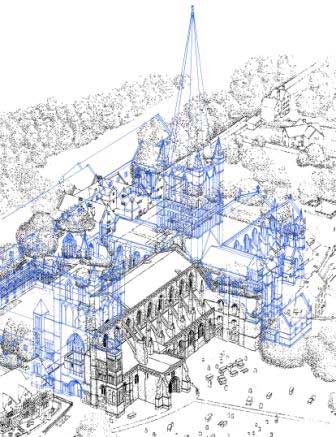
Malmesbury Abbey’s Architecture
Malmesbury Abbey is a fine example of Romansque architecture characterised by solid circular piers, plain capitals, arcades, chevron patterns and arcades as seen below.


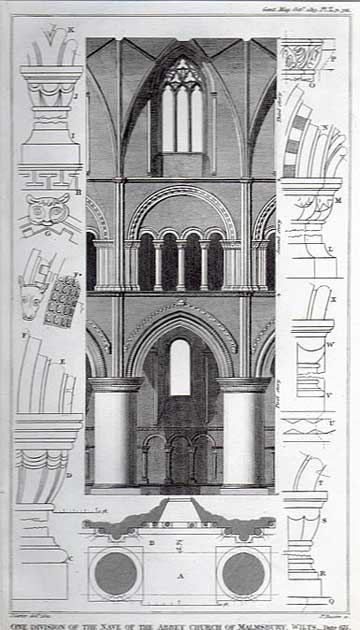
Typical rounded arches are joined by pointed arches in the nave and west wall of the south transept. This feature was becoming popular in England in the 12th century following French monastic design and points to the start of Gothic architecture.
The nave features grotesque mask heads with dog head stops shown below.
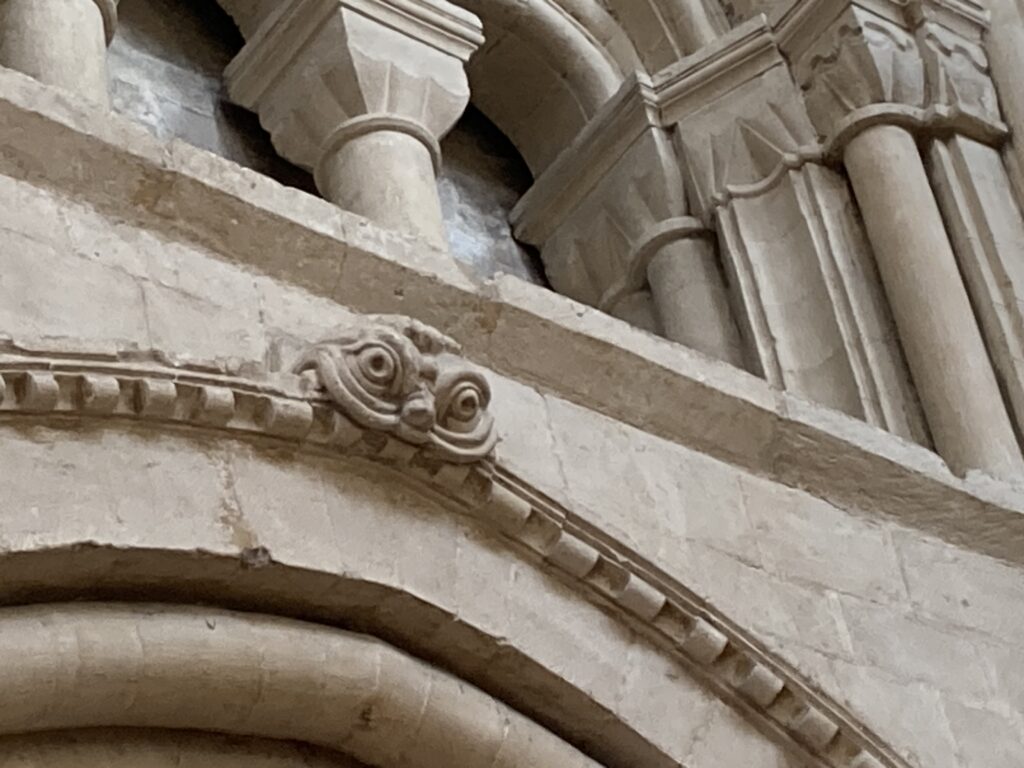
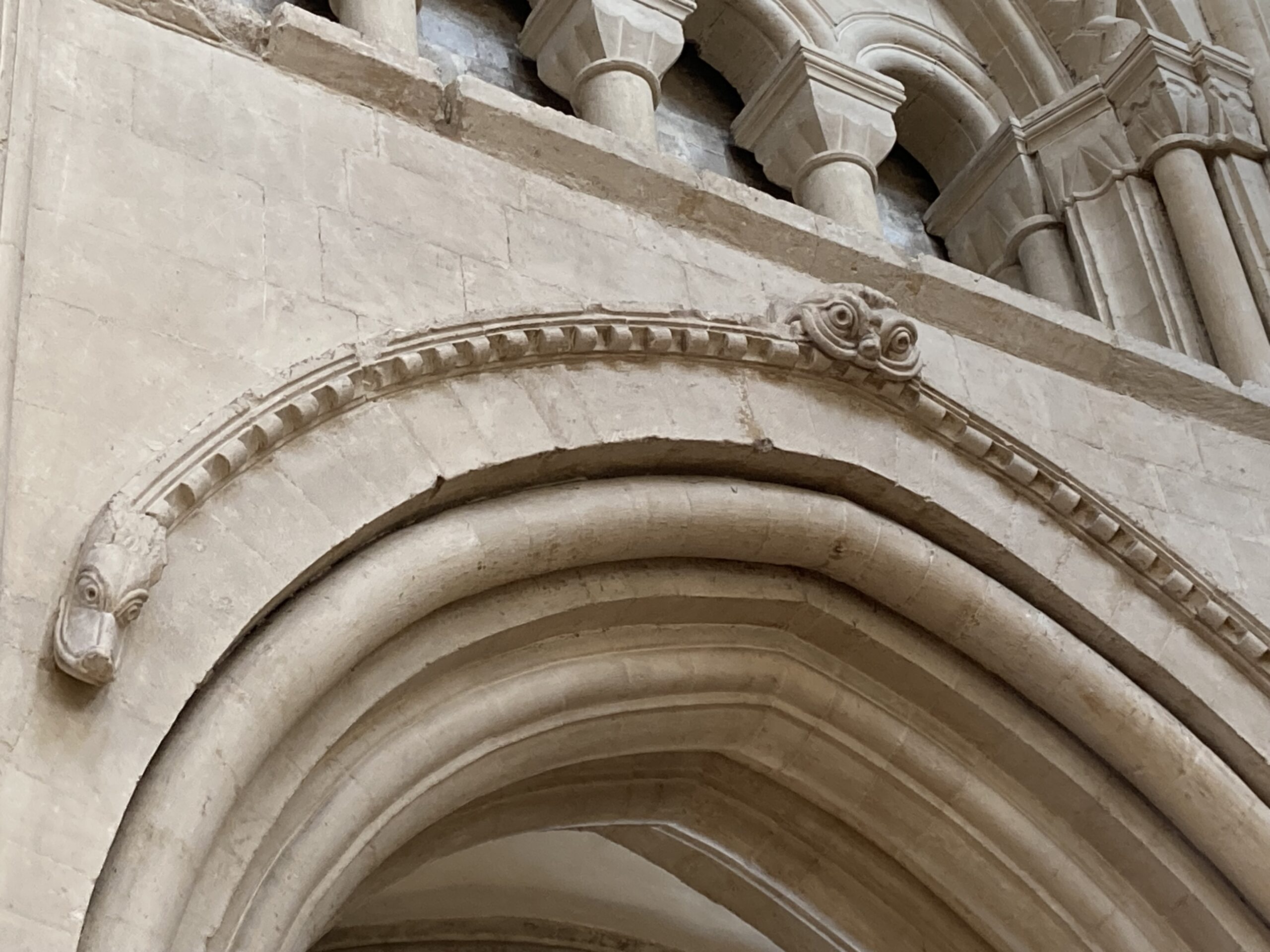
The South porch is among the best pieces of Norman sculpture in England. The carvings are contemporary with the 12th century Abbey. The almond shaped medallions contain figure sculpture of scenes from the Old and New Testaments.


Inside the porch are two lunettes facing each other each with six seated apostles and an angel flying above their heads. Above the main doorway, the tympanum has a Christ figure with two angels.
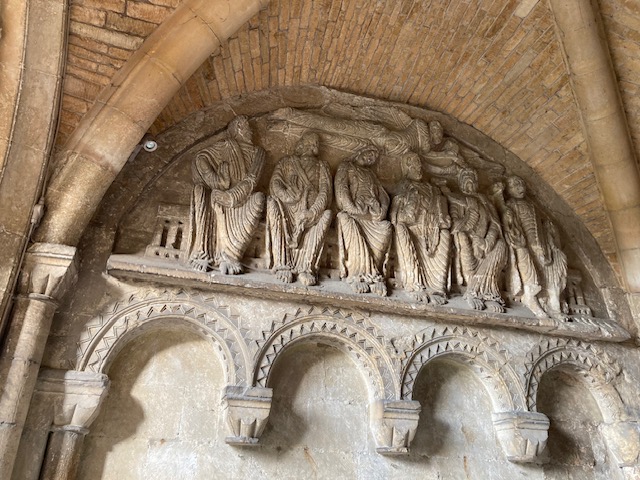
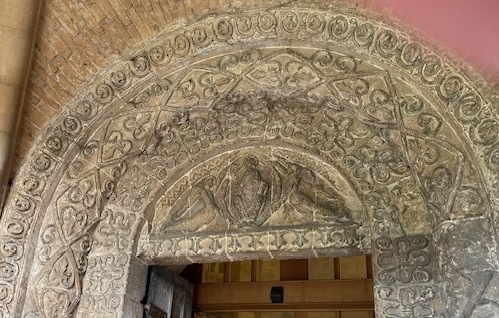
The definitive description of Malmesbury abbey was published by architect Harold Brakspear in 1913 in Archaeologia LXIV. Brakspear identified in Malmesbury Abbey the earliest examples of a number of the distinctive features which were characteristic of what became a West Country School of Architecture in the 12th/13th century.
The museum collection contains numerous drawings of architectural features of the Abbey.
Life in the Abbey
The new Abbey flourished. It became a major centre for Christian learning and a site of pilgrimage. As well as the tomb of St. Aldhelm, the Abbey housed numerous relics. There is no authenticated records of these relics but the magnificent Malmesbury Chasse now in a Canadian Gallery is believed to have housed a treasured relic.
Stories exist of the innovations that Abbey life brought, for instance in 1284, under Abbot William of Colerne, on St Martin’s day fresh water flowed into the Abbey lavatorium; it was brought by a conduit from Long Newnton, nearly four miles away.
The town of Malmesbury prospered alongside the Abbey and in the 13th century Abbot Loring erected a hostelry for visiting dignitaries on what is now the Old Bell Hotel. The hotel still has a hooded stone fireplace in the Bar which dates from this time.
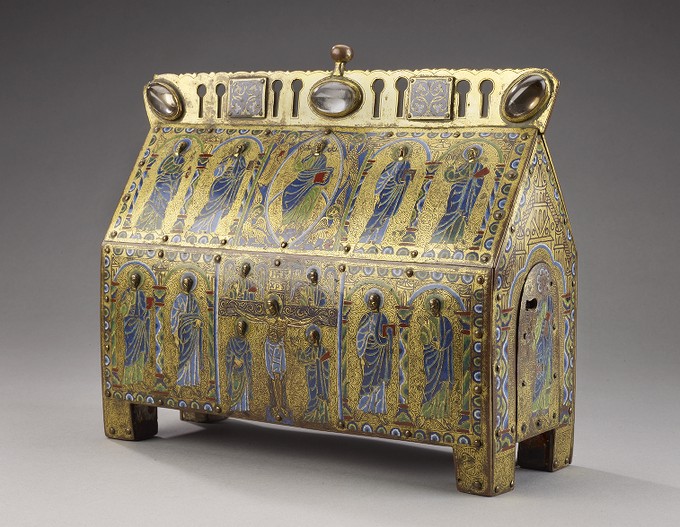
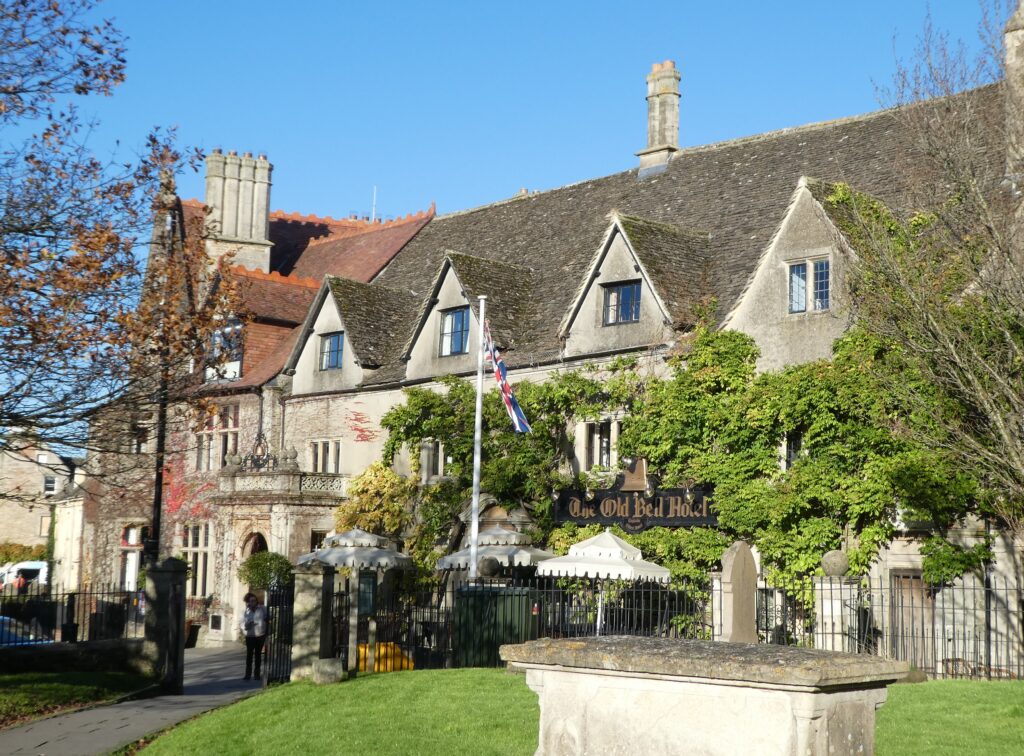
As a mark of the status of the Abbey building work and development continued throughout the 14th and 15th centuries. At the eastern end the presbytery was lengthened and a Lady Chapel added. A tower was built at the west end, the Romanesque clerestory windows were replaced with the present Gothic style, the wooden ceiling of the nave was replaced by stone vaulting and in the 15th century the cloisters were rebuilt.
Most spectacular of all was the spire that was built on the central tower. At around 140m high it was higher than that of Salisbury. It was built of timber with a lead covering. Sadly it was not to last. In 1542 Leland, visiting the town, recorded that the spire had fallen “in hominum memoria” (in living memory). It is thought that a lightning strike turned water in the masonry on which the spire stood, into steam so that the stone would have literally exploded. Down came the spire and the great golden ball on the pinnacle fell, so local legend has it, into the High Street, halfway down where the George Inn stood.
Malmesbury Medieval Library
The monastery at Malmesbury had a magnificent library under St. Aldhelm which contained a wide range of scriptural and patristic works. It was developed further in the 11th century under abbot Godfrey of Jumièges who appointed William of Malmesbury as his librarian. William was a great scholar he wrote original works, collected writings and books for the abbey church’.
Some manuscripts known to have belonged to Malmesbury Abbey do still exist and are documented as part of a Malmesbury History Society project. One of the most spectacular is Prudentius’s Psychomachia, which means ‘Battle of the Soul’. It is the first fully allegorical work in the European literary tradition and describes the battle between the vices and virtues for the Christian soul. A high resolution digital copy of many of the pages is available in the Athelstan Museum.
Malmesbury Abbey Lands
Malmesbury Abbey held very considerable estates both locally and further afield although most of the records are fragmentary.
The Malmesbury hundred, which the monastery held in fee farm, was granted to it in 1215 CE. A hundred was a division or area within a county which held its own court. It was formed by the merger around Malmesbury of the Cicemethorn (Chedglow) hundred to the north and the Suteledberg (Startley) hundred to the south. This large territory stretched from Crudwell in the north to Sutton Benger in the south, from Norton in the west to Brinkworth in the east (20 X 16 kilometres approximately). The monastery had an estate of 23,000 acres or 93km².
The abbot of Malmesbury had a lodge in the 13th century at Cowfold Park. This is thought to be Cole Park and to have been where the present house stands.
The document which transfers abbey lands to William Stumpe from Henry VIII in 1544 after the dissolution deals with three areas. The first consists of numerous messuages, yards and tofts at Rodbourne, the second refers to Brinkworth Manor and the third refers to lands around the Abbey at Malmesbury. Other land locally was sold to different buyers and doubtless the same happened further afield.
Later years
On 15th December 1539 Abbot Robert Frampton handed the Abbey to Henry VIIIth’s commissioners as part of the general dissolution of the monasteries. He and 21 other monks were dismissed and granted pensions.
The Abbey landed estate was sold off to different purchasers, a mixture of courtiers and local people. William Stumpe, acquired the Abbey site and precincts and donated the nave of the church to the town to be a parish church. This was to take the place of St. Paul’s, south of the Abbey that was in state of decay. The east wall of the nave was built to seal it off from the central tower and the quire which was taken down, reuse of some of the stone can still be seen in Malmesbury. Stumpe retained much of the site and other buildings to use in his wool cloth business. John Leland visiting in 1542 reported that “the abbey be full of looms to weave cloth on”.
The Abbey suffered further damage during the civil war. Assaults on the town were from the west along Abbey Row, so the Abbey ‘fielded’ much stray shot, marks can still be seen on the western walls. As shown on the Bird’s Eye View Map of Malmesbury dating from 1646, during the war cannon were hoisted on to the top of the west tower to give a greater range and to command the western approaches.
The four columns that had supported the spire still stood, but in 1660 the southeast one fell, it is suggested as a result of cannon fired to celebrate the restoration of the monarchy.
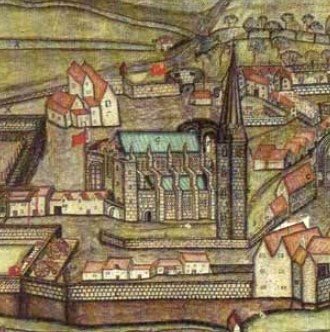
The tower at the west end fell sometime in the 16th/17th century, perhaps as a result of instability caused by demolition of the cloisters. Considerable damage was done to the entire west end of the Abbey. The Abbey Church was now reduced to the size seen today.
Then followed a period when Malmesbury did not prosper and both the Abbey church and its precinct suffered some neglect.

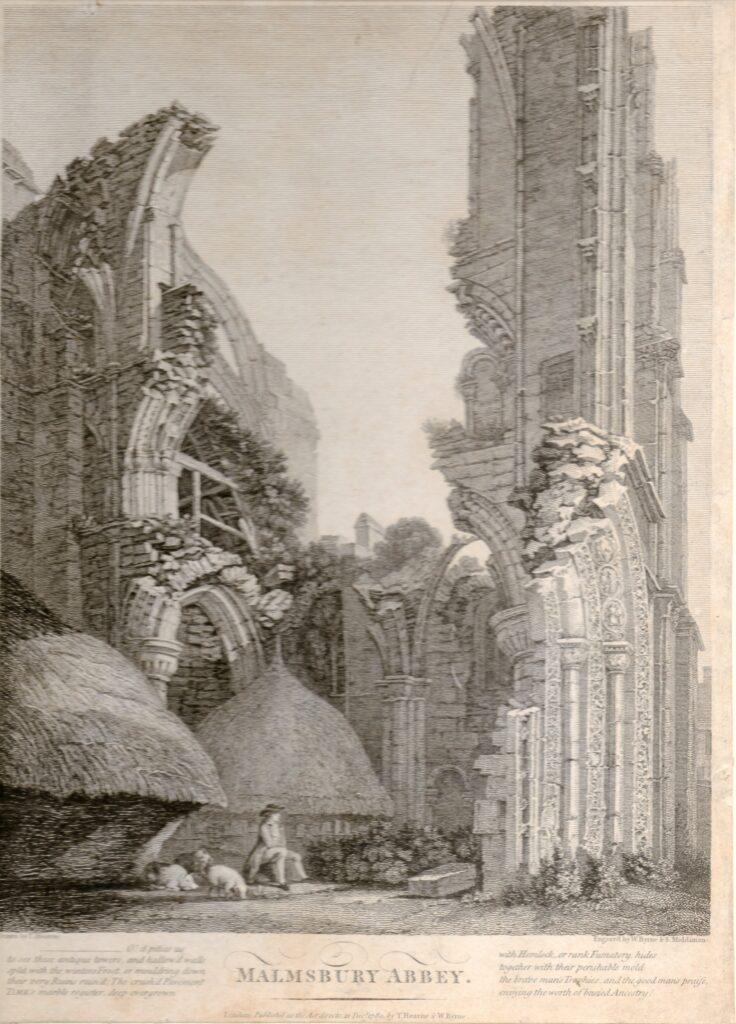
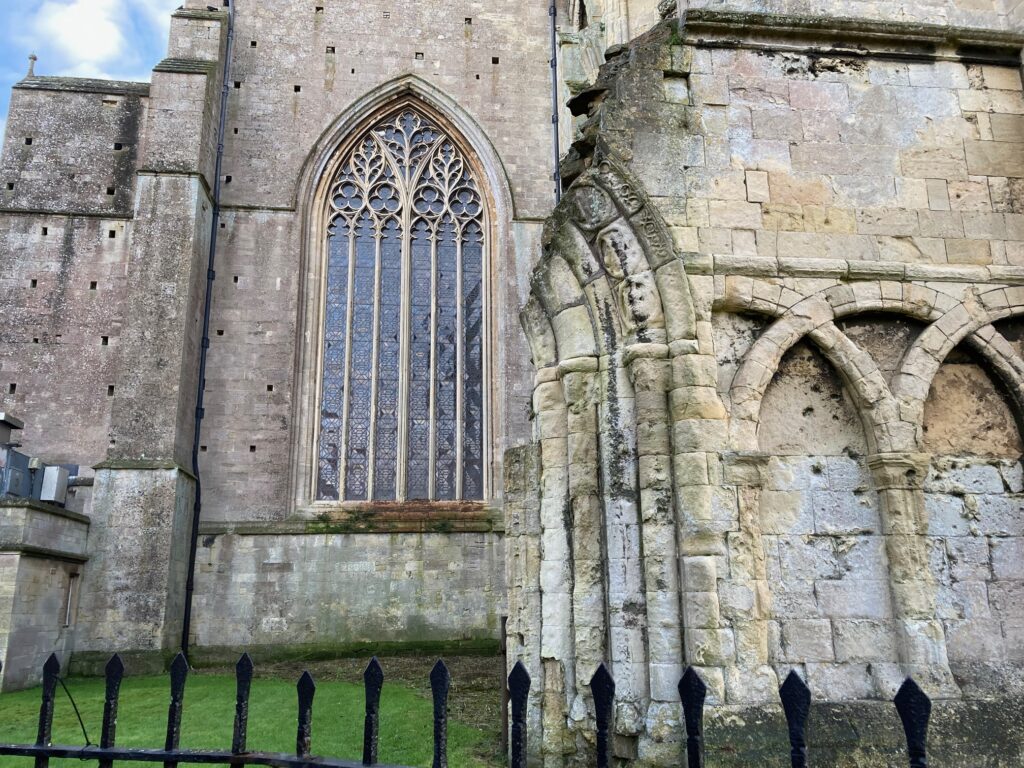
In 1822 considerable restoration took place. A gothic window was put in the west wall to replace the small original one and a gallery was erected beneath it. The architect was H.G. Goodrich of Bath who also designed the west window. More information on this restoration can be found on the Talks page of Malmesbury History Society.
The floor was raised 23cm (9in.) and new pews put in place. Ironically much of this work was removed a century later.
A cannon from the Crimea war stood beneath the ruined arches of the west end of the Abbey. When it went to fuel the drive for iron during World War II it required a Herculean effort from the biggest local shire horse to shift it.
By the end of Victoria’s reign the Abbey had deteriorated considerably, to the point of some parts being in danger of collapsing as shown below. The architect of the work was Harold Brakspear who had carried out considerable work in Malmesbury. It was completed by 1905. The southwest turret on the west front had been rebuilt as had the western end of the wall of the south nave. Buttresses were repaired and missing pinnacles replaced, other works were carried out to the drainage systems.


It was in 1927, after the consequences of the First World War, that further work was carried out on the interior. The Abbey closed for a year and in this time the gallery at the west end was removed, the organ was put into store, new choir stalls and pulpit were installed, the floor relaid and the east wall decorated with painted plaster. Athelstan’s tomb was also moved to the north aisle where it is today.
The east wall has attracted much attention and through the years its appearance has changed several times. Over the years committees have looked into options, a competition was held and many proposals put forward.
In the 19th century a painting of the Raising of Lazarus by Muziano hung over the altar.
After the 1928 restoration it was replaced by stencil painted plaster. The wash was stencilled with fleur de lys to represent hangings. In 1945 a large plain cross was placed above the altar. By the mid 1960s the paint on the wall had started to deteriorate, it was removed to leave the bare stone we see today.
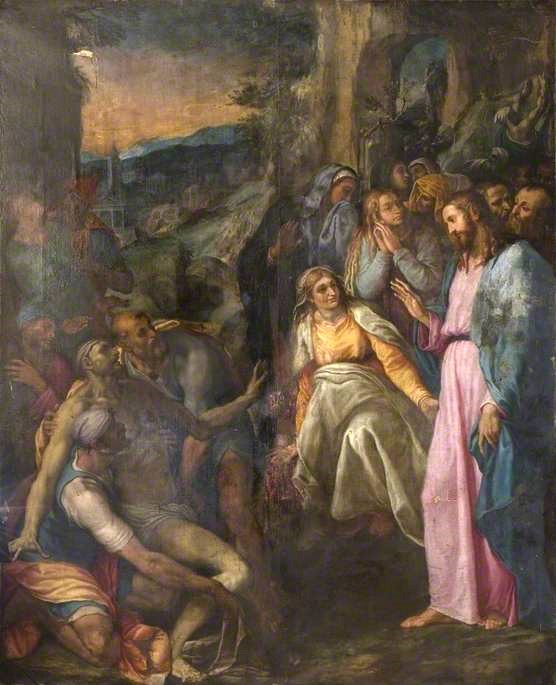
Birmingham Museum

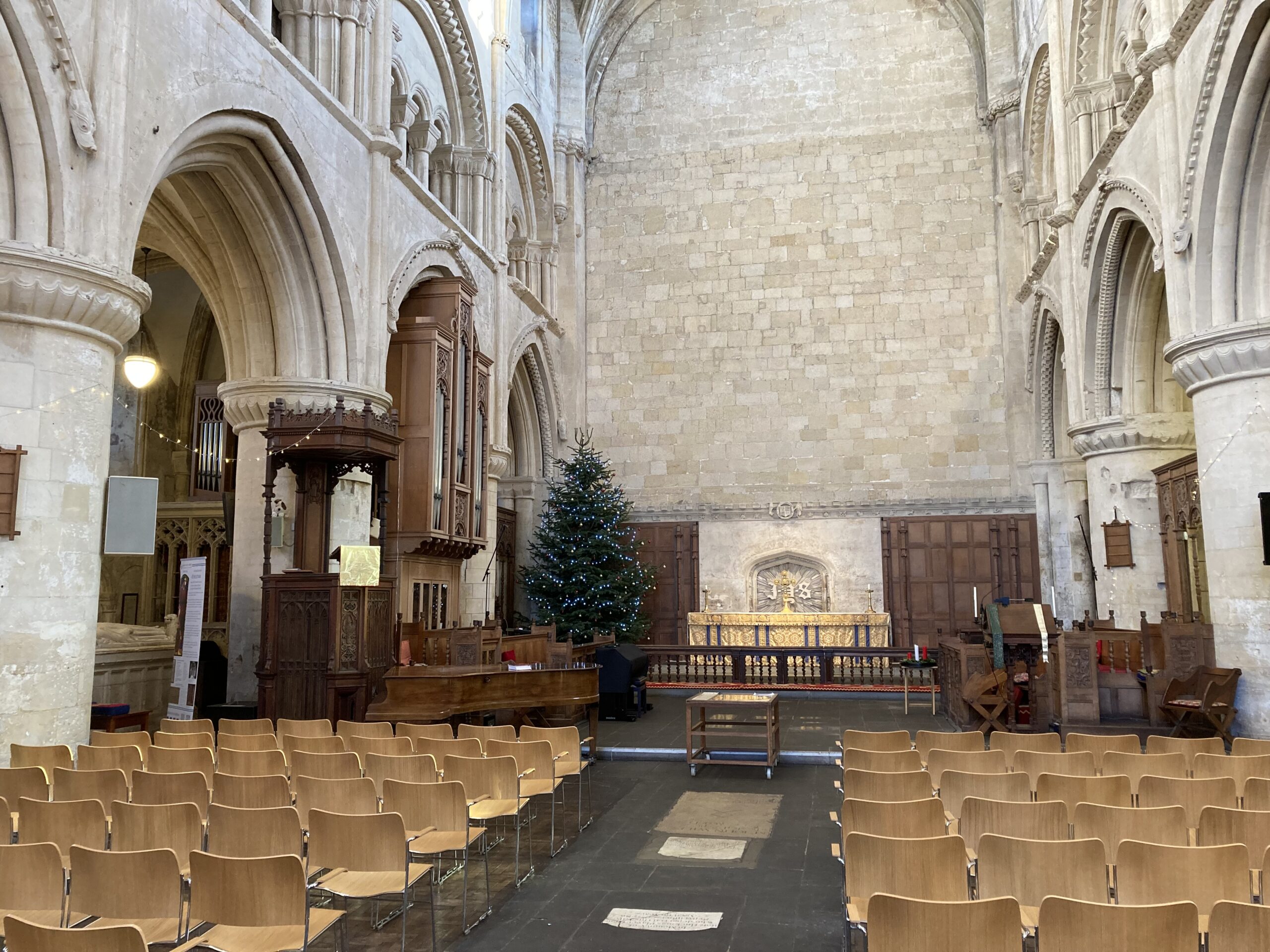
This can only ever be a brief history of Malmesbury Abbey. Books covering more detailed aspects are available from the Museum Shop.
Malmesbury Abbey – Today’s Church
The Abbey still dominates the town and the Christian community that worship there are an important thread in the life of the town.
Malmesbury is joined by the parishes of Westport, Brokenborough, Corston and Rodbourne. It is an ecumenical church with a wide range of services and activities.
Malmesbury Abbey website gives up to date information about visiting the Abbey, services and private prayer. Stewards are keen to help visitors enjoy the magnificent building.
The ‘Friends of Malmesbury Abbey’ was founded on St. Aldhelm’s Day 1945, an enthusiastic group of people that work independently from the Abbey who are passionate about preserving, restoring, enhancing and raising awareness of Malmesbury Abbey






